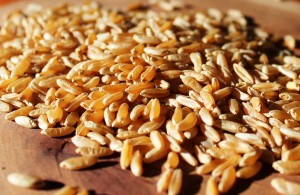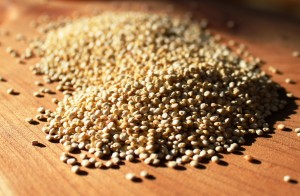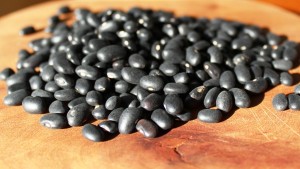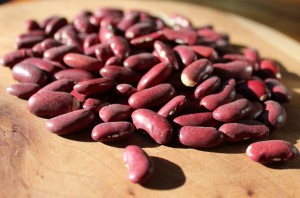Last week, Serenity in the Storm reader, Kevin posted the following comment on the Breakfast Quinoa post:
“I would love a blog entry where you share what are your vegan pantry staples – for those times when you just need something good to eat and have to use what is on hand.” ~ Kevin
Thanks to Kevin’s inspiration, here begins the series on pantry basics. Initially, I thought about doing one big post on what I tend to keep stocked in our pantry for easy meals, but quickly decided that it would be long and unwieldy. The first pantry basics feature will be on grains and legumes.
—-

Keeping a well-stocked pantry is one key to success for maintaining a well-balanced vegan diet. Plus, it’s good to have lots of options on hand to ensure that you don’t feel deprived or like you’re missing out on foods you used to eat. Whole grains and legumes should be the foundation in any vegan kitchen. Not only do they provide great nutrients and filling meal options, but they keep well in the fridge for days. I try to keep at least one container of cooked grains and one of beans or lentils in the fridge at all times for those days when you just don’t know what to eat and aren’t inspired to cook anything spectacular. It’s easy to throw together a meal with grains, beans, a vegetable and some seasonings. Plus, having these around provides a great lunch option whether you take your lunch to work, or eat at home. I buy grains and legumes in bulk, either at Costco (for quinoa and brown rice) or in the bulk section at the local co-op or Whole Foods. These are the grains I try to keep stocked in our pantry:
Short grain brown rice: A good, standard brown rice. Hearty and chewy. The difference between white and brown rice is that brown rice has retained its outer coating, making it a healthier, more nutritious choice. Cooking Instructions: water ratio is 1:2 (grain: water). Bring rice to boil with a tiny splash of olive oil, a little salt and pepper (or other seasonings of your choice). Turn down to simmer, cover, and let cook for 50 minutes. Turn off heat. Let stand 10 minutes.
Arborio rice: Arborio is a short-grain Italian rice, used for risotto. It is very creamy and you can see a recipe for risotto here.
Sweet brown rice: Sweet brown rice is a sticky rice, good for dessert rice dishes, or for sushi. Cooking instructions: water ratio is 1:2 (grain: water). Bring rice to boil with a tiny splash of oil. Stir once. Cover with lid. Reduce heat to simmer and cook 50 minutes. Remove from heat, let stand in covered pot for 10 minutes. Fluff with fork, and for sushi rice, add salt and brown rice vinegar to taste.
Kamut: An ancient grain form of wheat (much larger than normal wheat). This grain is one of my favorites. It’s very chewy and nutty. I find that I like to eat it with nothing on it because it’s so flavorful. It also has a lower gluten content than regular wheat. Cooking Instructions: Cook using the abundant water method (like you would cook pasta), simmering for 50 minutes. Drain water.

Quinoa: Quinoa commonly comes in two colors–red and white. I personally adore the red variety, but usually buy the white variety because it’s what is available in bulk at Costco and tends to be cheaper than red in other bulk sections. Quinoa is a complete protein with a nutty flavor. Good as a savory or sweet dish, depending on what you add. Cooking instructions: water ratio is 1:2 (grain: water). Bring quinoa and water to boil. Stir once. Cover with lid and turn down heat to simmer for 15 minutes. Turn off heat and let sit for 5 minutes. Fluff with fork.
Oats: There are all kinds of oats out there. I generally try to stay away from the quick-cooking oats because I figure they are further processed than other varieties and they’re a little mushier, in my opinion. Steel cut oats are oat groats which have been cut down from their original size. Rolled oats are steel cut oats which have been rolled/flaked (there are different levels of the rolling, which produce the regular, quick-cooking, and instant varieties). I like Bob’s Redmill Steel-cut oats and their rolled oats. Also, Bob’s Red Mill has gluten-free oats available.
Cornmeal: Coarse-ground cornmeal is ideal for polenta or for grits. Finer ground cornmeal is used for things like cornbread. I love cornmeal in all its forms.
Israeli/Middle-Eastern Couscous: Not a whole grain, but a fun and delicious pasta-like grain in tiny ball shapes. Cooking instructions: Boil using abundant water method for 10-12 minutes (taste for tenderness). Drain water.
Millet: An ancient grain with a slight nutty/corny flavor. Cooking instructions: water ratio is 1:2 (grain: water). Bring millet and water to boil. Stir once. Cover with lid and turn down heat to simmer for 15 minutes. Turn off heat and let sit for 5 minutes. Fluff with fork.
Bulgur: Bulgur is a form of wheat, made by boiling, dring and cooking whole wheat grains. If you are going to eat it raw, like in tabouleh salad, you can simply reconstitute it by soaking it in water for an hour or so (ratio of 1:2, bulgar: liquid). You can also throw it in soups or eat it as a breakfast cereal.

Legumes, such as beans and lentils, are an essential staple for any vegan cook. Recently, I’ve been making an effort to buy only dried beans and lentils in order to avoid the canned food thing. Many canned foods contain BPAs and they also use unneccessary packaging. That being said, I usually keep a can or two of beans in the house for emergency situations when I don’t have time to cook them from scratch. Cooking instructions for beans and lentils: To cook beans from scratch, you must first wash the dried beans in cold water and pick out any rocks, dirt, etc. Put beans in a large bowl and cover generously with water. Soak overnight. Note: you do not need to soak lentils. For bean/water ratio and cooking times, see below. My favorite beans and lentils:
Black Beans: For chili, stews, refried beans, bean salads, burritos, beans and rice, etc. black beans are great. It’s probably my favorite all-purpose bean and I’ll tend to throw these in anywhere I can. Cooking: 1 cup beans: 8 cups water, simmer for 1.5 hours (Yields 4 cups).

Kidney Beans: I like kidneys beans for Chipotle Chili, or for the Indian dish, Rajma, or for any other dish where a hearty bean is called for. Cooking: 1 cup beans: 6 cups water, simmer for 1 hour (Yields 4 cups).
Great Northern Beans: A variety of white beans, these are good for baked bean recipes or for minestrone/ vegetable soups. The Basil, Kale and White Bean Soup uses these beans. Creamy and lightly flavored. Cooking: 1 cup beans: 7 cups water, simmer for 1 hour (Yields 4 cups).
Chickpeas/Garbanzo Beans: Chickpeas/Garbanzo beans are used in dishes like hummus, or in salads, soups, or curries. I like the Curried Chickpeas recipe, but chickpeas are a highly versatile beans with lots of different uses. Honestly, I usually just buy canned chickpeas because I don’t use them that often, and when I do, it’s usually spontaneous.
Pinto Beans: I grew up on pinto beans cooked in pressure cooker. Along with black, pinto has always been our go-to bean. Available cheaply in bulk and really tasty. Cooking: 1 cup beans: 6 cups water, simmer for 1.5 hours (yields 4 cups).
Red Lentils: These lentils do not have the husk and so they break down quite a bit when cooking. For a lentil stew, these are great. Cooking: If not adding to stew, cook 1 cup lentils: 1.5 cups water. Boil water first, add lentils, boil for 2-3 minutes. Reduce heat to simmer and cook until tender (about 25 minutes).
Green Lentils: Green lentils are often the cheapest and highest in protein of the options at our local co-op. They are large and hold their shape fairly well. A great ‘everyday lentil’. Cooking: If not adding to stew, cook 1 cup lentils: 1.5 cups water. Boil water first, add lentils, boil for 2-3 minutes. Reduce heat to simmer and cook until tender (about 45 minutes).
French Green Lentils: These are tiny lentils that are a blackish green color dried, and add a nice ‘pop’ to the dish they’re in. They hold their shape very well and are quite tasty, but tend to be more expensive than the brown lentils. Cooking: If not adding to stew, cook 1 cup lentils: 1.5 cups water. Boil water first, add lentils, boil for 2-3 minutes. Reduce heat to simmer and cook until tender (about 45 minutes).
What are your favorite grain and legume staples? What have I forgotten?
 Follow
Follow

Thanks for this great set of easy-to-read and -follow notes on grains and legumes. One trick i’ve learned (from burning grains almost every time i cook them) is that anything that is 2:1 can be easily cooked in a rice cooker. It’s cut down on burning and actually makes cleaning a lot less messy as less of it sticks to the pot and less sputters out across the stove top (especially those pesky dark grains – they can make such a mess on the stove). Plus, i can put the pot on, walk away and space out without worrying about forgetting it (as i’m apt to do – can’t tell you how many dinners i’ve burned just wandering off and being distracted).
Thanks, Tish! Great point about the rice cooker. We don’t have one, so I don’t think about them, but we definitely have burned some rice because of it. And I know for a fact, my dad would be alot safer and eat a lot less burnt rice if he had a rice cooker too.